Sigma Opens Up About Lens Design, a Problem with Gear Reviews, and More
![]()
While attending the CP+ 2023 show in Yokohama earlier this year, I visited with Kazuto Yamaki, CEO of Sigma Corporation, and one of the most savvy executives in the entire photo industry.
David Etchells: It’s good to see you as always; readers appreciate your open and straightforward style in interviews so much. (One online commenter said that your interviews “are a joy to read”)
Kazuto Yamaki: Thank you very much.
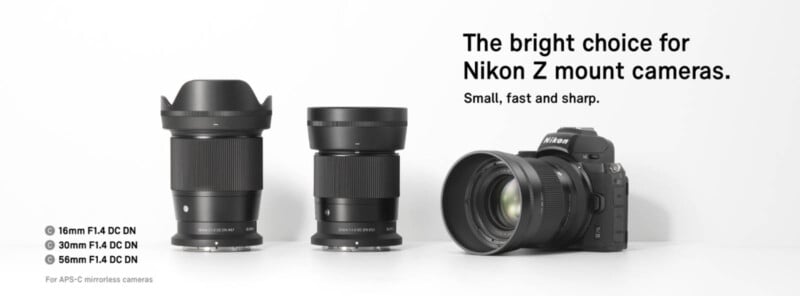
Sigma Lenses for the Z Mount! How About Full Frame?
DE: I think one of the bigger pieces of news here is that you’re bringing some of your excellent APS-C primes to the Nikon Z mount. (Congratulations!) I think this is a very positive development not just for Sigma but for Nikon as well.
KY: Yes, we had a very good response from the Nikon Z mount users.
DE: Oh, the users have been very positive?
KY: Yes.
DE: I think it’s really a strength for camera manufacturers to have third-party lenses available for their platforms.
KY: Yes, I think so, it gives great benefit for the customers, the customers have more choices.
DE: It looks like Nikon opened up their mount for APS-C, but not for full-frame yet. Do you have plans for full-frame Z-mount lenses?
KY: Right now we don’t have a plan for the next lenses yet. We’d like to release these three lenses first and see what the response is from the Z-mount users. And then I hope we can make a plan for the next products.
DE: And likewise, you have your little 18-50mm, which is such a nice little APS-C lens, that would be very good to see on Z mount.
KY: Yes, it’s very compact and lightweight.
DE: Are there any plans to bring the 18-50mm f/2.8 DC DN to Z-mount?)
KY: Sigma has not decided on plans after these three lenses and will consider market feedback before deciding on a future course of action.
Nikon opening the Z mount for third parties is very good news for anyone using or looking to adopt the platform. The availability of third-party lenses is a strong point in favor of any mount system.
The AF Drive Itself Needs to Change for Different Mounts?
DE: The press release mentioned that the AF drive and lens/camera communication had been specifically optimized for the Z mount. Of course the communication with the camera body would need to be changed to match a different system, but I was surprised that the AF drive itself was changed as well. What was the nature of those optimizations?
KY: Actually, the communication between the camera and lens is quite different from other systems, because it’s their own system, Nikon’s system. So we had to develop the firmware from scratch, just for Nikon.
DE: So it was a whole different processor?
KY: Ah – no, the same processor could be used, because it’s designed as a very general-purpose CPU for interchangeable lenses, and we can program the CPU for each system.
DE: Ah, that makes sense. The Z mount has a number of communication channels, meaning there’s a large number of pins in the interface. So you maybe needed more IOs to handle the communication than usual?
KY: Right.
While Sigma could still use their universal lens CPU, the Nikon Z mount involved more/different digital communication channels than other lenses, and of course the format of communications between the lens and camera body is different. The fact that Yamaki-san made specific reference to differences in the Z mount suggests that it required a bigger change in the lens/camera interface than other platforms in the past. When asked for more detail on this point, though, Sigma replied that they aren’t able to discuss details about the interfaces and communications of other brands’ cameras.
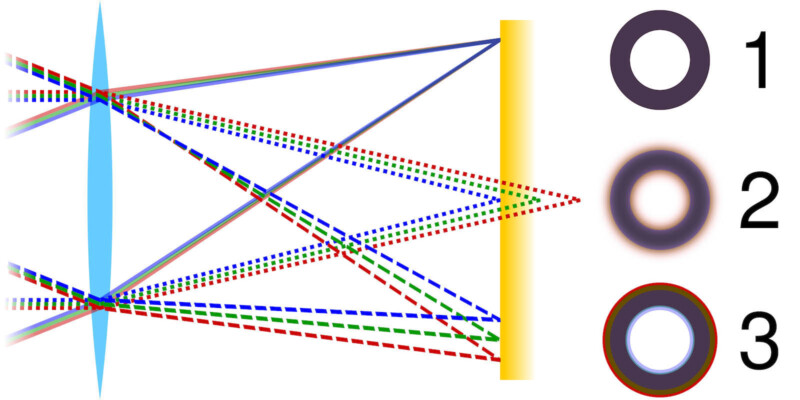
Sigma Lenses Work With Nikon’s In-Camera Aberration Correction
DE: One of the most surprising aspects of the announcement was that the three primes are compatible with Nikon’s in-camera aberration correction (on selected bodies that offer that feature). I was very pleased to see this and think it’s great that Nikon extended the full capability of their platform to your lenses. Does this support require any firmware updates by Nikon, or is all the information needed for the camera to make the correction contained within the lens?
KY: Yes, the camera reads the data in the lens; the lens responds to a command from the camera [and provides the correction data], and the camera uses that data to correct the image.
DE: That makes sense. I forget who it was very early on, that stored the correction data in the body, so each new lens needed a camera firmware update to support it. I don’t remember who it was, maybe Olympus, with their original Four Thirds system, before Micro Four Thirds was developed? I’m not sure who it was, but remember that being a way it was done in the very early days.
This was particularly surprising to me, although it at the same time makes perfect sense. In the past, some camera makers haven’t allowed third-party lens manufacturers to take advantage of in-camera aberration correction. In modern lens design, this would constitute a significant disadvantage. As Yamaki-san noted, being able to relax constraints on things like geometric distortion, chromatic aberration, and vignetting lets lens designers reduce size and weight while still controlling for things like curvature of field and longitudinal CA that are hard to correct for post-capture.
How is Correction Data Communicated to the Camera Body?
DE: I’m curious about how detailed this information is. You may not be able to answer this due to an NDA with Nikon, but how is the aberration information communicated to the camera? For example, is it a single number or pair of numbers for geometric distortion, or is it some higher-order function, to be able to handle things like “mustache” distortion? Are things like chromatic aberration represented by a single number or pair of numbers, or is the aberration mapped out across the frame?
KY: To be honest, I don’t know. I do know that we need to collect data on distortion and vignetting. I’m not sure about chromatic aberration…
DE: I would expect that CA is compensated for because I remember that even back in the DSLR era, Nikon’s 18-135mm had pretty bad CA from the lens itself, but the camera bodies corrected for it.
KY: I can’t tell which cameras specifically, but some cameras analyze the image itself and measure the chromatic aberration and then correct it. So I don’t know what kind of technique Nikon uses. Maybe our engineers know it, but there are two techniques: Some cameras can use data from the lens, but others can analyze the image itself.
DE: Wow, that seems very powerful. I’m a little surprised that they can reliably tell what’s CA and what is just subject detail.
The first time I became aware of just how big a difference in-camera aberration correction could make was with the Nikon 18-135mm kit lens. It was quite sharp and lightweight for its focal length range, and the in-camera JPEGs from it looked great. When I looked at the RAW images though, they had a ton of CA, especially in the corners. Modern image processing chips are so powerful that lens designers can rely on the camera to handle a lot of aberration correction, letting them optimize other lens characteristics without adding size, weight, or cost.
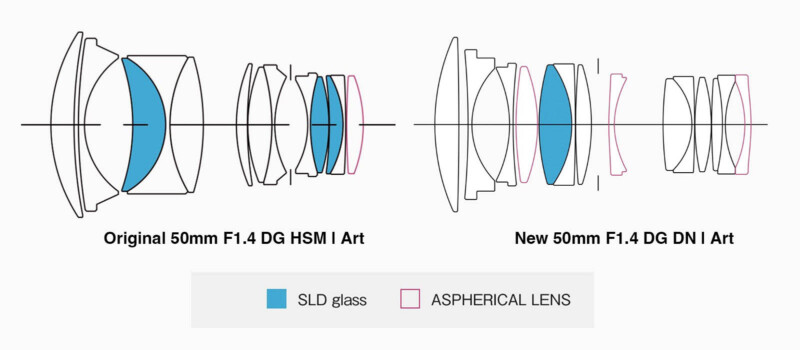
The Original 50mm F/1.4 Art Was Amazing, How Did You Make the New One So Much Better?
DE: You just announced the new 50mm f/1.4 DG DN Art lens. I remember how impressed we were at IR with the original 50mm f/1.4 DG HSM Art when you released it back in 2014, and the fact that it competed so strongly against the Zeiss 50/1.4 Otus, which cost almost $4,000. Your 50mm f/1.4 DG HSM Art was one of the best lenses we’d tested at the time, but when I saw the MTF curves for the new model and compared them with the original, I was blown away(!) The new lens is almost sharper at the edges than the original was in the center. Looking at the optical diagram, it seems like almost nothing is the same as the original, it’s a completely different design concept. I never know quite how to ask these questions, but what can you tell me about the design of the new lens, what the process was that led to it, and how did the designer manage to so far surpass what was already an exceptional optic? (The general question I’m always trying to ask is how did they come up with that design approach, where did they start?)
KY: It depends on the project, but in the beginning, we discuss the main concept of the lens and then the optical designer puts their own ideas into the design. Then they try to finalize the design from there.
DE: So it starts with a concept, the designer creates an initial expression of that concept, and then they iterate from there.
KY: Yes, right. So for example, in choosing the concept, if we decide to achieve the best possible optical quality, at the cost of the size and the weight, then the optical designer is supposed to achieve the best possible optical performance without worrying about how big or heavy the lens is. Or we might say “This lens must have almost zero chromatic aberration, longitudinal aberration” — things like that. In this case, the optical designer really likes photography. I’ve known him for over 15 years because he has been working for Sigma for 16 or 17 years, and he sits very close to me, so I know how he spends his lunchtime. After he has lunch, he always checks the images taken with different kinds of lenses. He can sometimes download an image from your website, an image taken with let’s say a Canon 35 f/1.4 or 24-70/2.8 or something like that. He’s always comparing the lenses’ MTF curves and sometimes the intellectual property of the lens (the patent) and then he looks at the sample images. He always compares what is an ideal lens that provides the best results in the images. His conclusion for this lens was to achieve very consistent optical performance from center to edge. And then he decided to go that direction. These days, almost all lenses perform very well; the human eye can’t tell the absolute sharpness or contrast, but we are sometimes disappointed if we can see a significant difference in sharpness from center to edge. Even if the center looks very good, if we see some aberration in the corner, we may be disappointed. So this optical designer wanted to achieve very equal performance from center to edge. That’s the concept that our designer input into this lens design.
DE: That’s very interesting. As you said, pretty much any lens is great in the center at f/8, the challenge is making it better at the edges – and wide open. I probably know the answer to this, but I want to ask what are the key technologies that made the design possible. One thing I see is that there are a lot of aspherics in it, more than I would expect to see in a standard focal length vs wide angle. You’ve got 3 aspherical elements and at least one of them, the focus element, is double-sided. Are there other double-sided aspherical elements in it, or are the others just single-surface aspherical?
KY: I … don’t remember.
DE: Yeah, I’m getting way into the weeds here… But looking at the MTFs, I mean these are the MTF curves for the old version and these are the curves for the new one, and I couldn’t believe it.
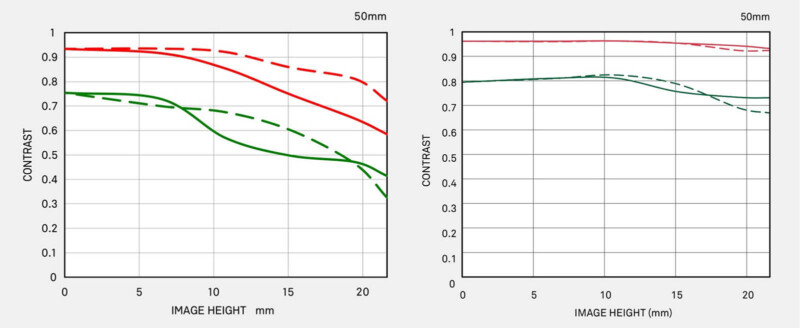
What Led to Such Dramatic Reductions in Aberration With the New 50mm f/1.4?
DE: Reading the bullet points from the announcement, it seems that you paid a lot of attention not only to sharpness but also to reducing astigmatism and curvature of field. In particular, it mentioned suppression of comatic aberration at the periphery, to provide excellent rendering of starscapes. This is probably too far in-depth, but can you point to specific aspects of the design that led to these improvements?
KY: You mean longitudinal chromatic aberration or comatic?
DE: In this case I’m talking about comatic aberration. (The tendency for point sources of light at the edges of the frame to turn into blobs with tails, looking like little comets, hence the name.) Are there specific aspects of the design that help with that? Maybe this is maybe a question for the lens designer, though…
KY: In general, the aspherical elements help to correct the coma. Especially if we use aspherical elements in the rear part of the lens it helps to correct that. That’s a general concept, but if we use aspherical elements in the front area, it helps to correct aberration in the center, while aspherical elements in the rear help to correct aberration in the periphery.
This was an interesting tidbit that I hadn’t had before: aspheric elements in the front of the lens help more with controlling aberration in the center, while ones towards the back do more to correct aberration in the sides and corners of the frame.
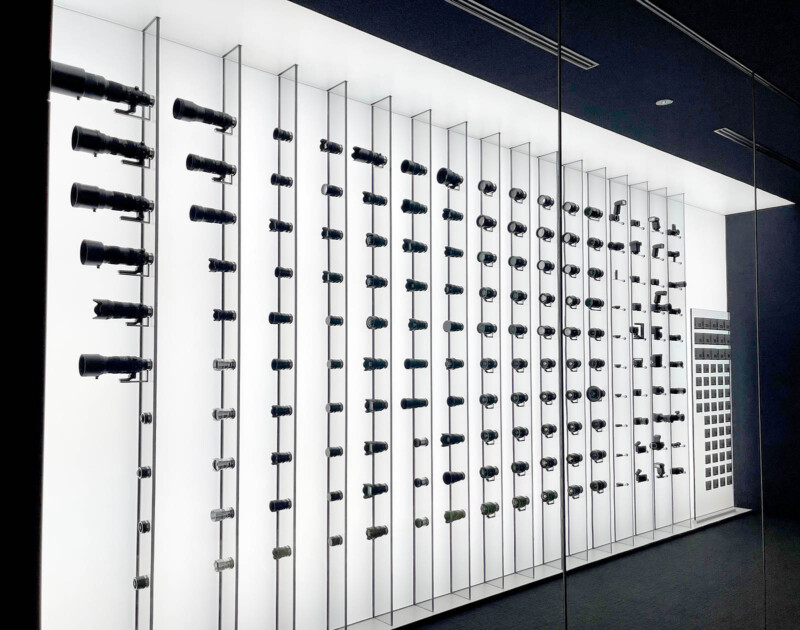
Optical Design Doesn’t Actually Start With a Blank Sheet of Paper
DE: Oh really? That’s very interesting! I see in the previous design, the one aspheric was at the back, and now this time you have three: one at the front, one in the middle, and the third in the back. I love hearing about these things, because lens design is always such a mystery to me, how they go from a blank piece of paper to the final design – and you know, the process they go through to decide “Well, I’m going to arrange the elements like this, you know I’m going to put a plano-convex here and a double-concave there, and this one will be ED glass, etc, etc.” I’d love to know what goes on in the designer’s mind to arrive at that.
KY: I may disappoint you, but optical design does not start from scratch. They always choose some kind of starting point. Like if we have … in this case, this one (the previous version) was for DSLRs, and the new one is for mirrorless. So the optical designer had to forget about the first one, but he can start from this lens construction and change it for a mirrorless camera. I don’t know how he started this one. But just as an example, he could start with the 35mm f/1.4 and change the focal length to 50, that kind of thing. Then he adds some elements and takes some elements from the original construction. So all optical designs start with some kind of what we call “start data”.
DE: Ahh – it always starts with some kind of a previous design. That makes sense to me because I couldn’t imagine just pulling an idea out of mid-air and saying “Well, I’ll just put this element here”.
KY: We have a huge database of what we have already done. There are so many lens designs from the past, so the lens designers can choose one from our database.
DE: Ah, hai, hai. [Japanese for “yes, yes”] I can see that there are similarities, even though they’re very different. Like in the front, the front several elements in the new design are quite similar to the original.
KY: So obviously he checked the different lens constructions from different lenses as the start data.
DE: Ah yes. I don’t know if it would be possible without giving away proprietary ideas, but I’d love to be able to talk to a lens designer and have him walk through the process, like “we started here, and then to improve the edges, I saw that I could do this, and then I thought, well, let’s swap the elements and …” I’d love to hear what that process was.
KY: Very good. If you’d like we could provide such an opportunity for you.
DE: Oh, that’d be great. Maybe when I come back for next year’s CP+, assuming I can make it then. That would be wonderful, and I think people would be so fascinated by how that works, how that happens.
This finally explained to me how on earth designers figure out what lens elements to put where when starting a new design: They basically begin with an older design and then tweak from there. Yamaki-san didn’t say so himself, but I suspect that designers may even borrow different parts from different previous designs. I can imagine them taking the front elements from one design, a different focus group from a second, and the rear elements from a third. Sigma has created so many lenses over the years that they have an enormous database of “start data” for their engineers to leverage in their new designs.
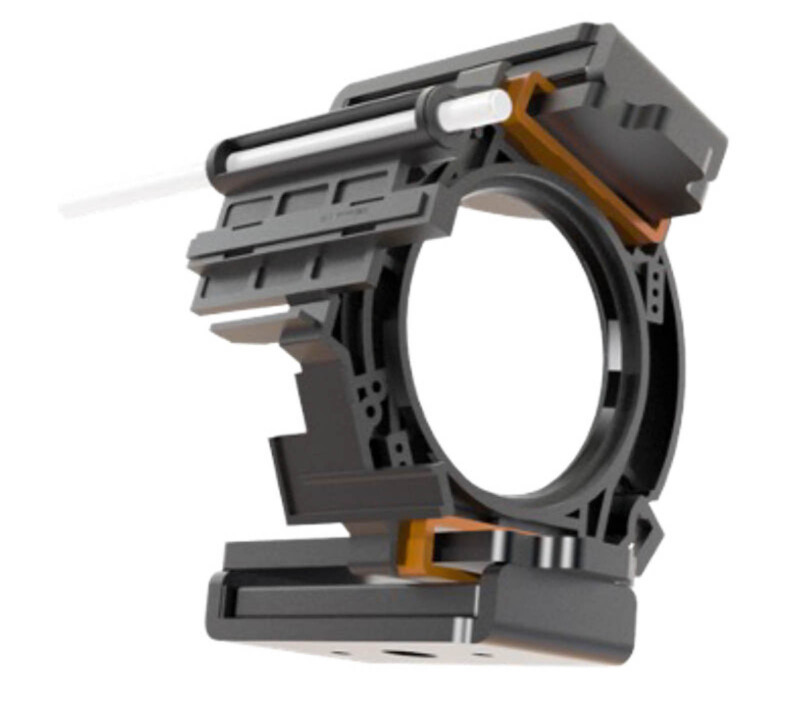
HLA Focus Motors, a First for Art Lenses?
DE: This is also the first time that an HLA (High-response Linear Actuator) was used in an Art Series lens to drive the focus element. I gather that the HLA technology has been used in other, non-Art lenses in the past(?)
KY: We first introduced HLA for the 60-600mm f/5-6.3 DG DN Sports, the long tele zoom lens. So this is the second lens we used the new HLA in.
DE: How much of an improvement in speed and/or precision does it give, compared to your previous AF drive technology?
KY: The response of the motor, of the HLA, is much faster than a stepping motor. So the lens CPU sends the command and activates the focus motor, but then the response of the HLA is much faster. So it works very well and of course helps to achieve fast autofocusing, but it also helps to implement better focus tracking for movie AF and continuous AF.
DE: So the time from when the processor gives the command until when the motor has completed the move is much shorter?
KY: Yes.
DE: And is it also more powerful, does it generate more force?
KY: In general, yes, they have more power. But if we wanted to make it more powerful, it would become bigger.
Like a number of other manufacturers, Sigma is starting to use linear motors rather than stepping motors or larger ultrasonic motors for their focus actuators. A linear motor basically takes the coils and poles of a conventional rotary motor and lays them out flat next to each other. As this technology has advanced, it can generate high thrust in a compact size, while not wasting energy turning a gear train.
Do Linear-Actuator Focus Motors Help Reduce Lens Size?
DE: When I was talking to another manufacturer, I also heard that another advantage of linear motors is that they help make the body more compact, and you also don’t lose energy in a gear train, because you don’t have to convert rotary motion to linear.
KY: Oh yes, yes.
DE: Yeah, and you have to have space for some round thing, to fit it in, whereas the linear motor is much slimmer.
KY: Hmm…
DE: But of course, you said to make the linear motor more powerful, it gets big quickly.
KY: Yeah, in the case of a stepping motor, the diameter is quite small, so we can put it in the rear of the focus unit [so it doesn’t really take up much space beyond what was already available]. When it comes to the linear motor though, it always has to be placed outside of the focus unit. So I don’t believe it always reduces the size. It really depends on the lens type, but I don’t believe it always helps to reduce the size.
DE: So previously the focus motor could be back here (gesturing to the back of a lens)
KY: Actually, this lens uses an HSM. [A hypersonic motor, a different technology that uses ultrasonic vibrations to move the lens elements.]
DE: Oh, so it’s an HSM in this one.
KY: In general, in the case of the stepping motor, this is the focus unit (pointing to the focus element on a lens diagram), we can place a motor on the back side of the unit.
DE: Ah right, so it’s out of the optical path but it doesn’t increase the diameter of the body. Whereas here, the HLA has to be right next to it.
KY: Right, outside the lens unit. [That is, outside the envelope of the focus unit, potentially increasing the body diameter.]
This was something that hadn’t occurred to me. I’d always viewed the focus motor as being something that lens designers had to make room for. As it turns out, the natural taper in the size of lens elements moving from the focus group back gives them some extra space essentially for free. The motors still need to be tiny, but they can be tucked into space that isn’t needed for optical elements or their supports. While linear motors can occupy less space overall, they need to be positioned directly adjacent to the focus group, which might actually increase the diameter of the lens barrel.
DE: Another factor with this new model is that the focus group is now just a single element, a single double-sided aspheric. So obviously it’s very light to begin with, plus you have the HLA to drive it. In general, would double-sided aspherics be used to reduce focus group weight? Is that a general technique that could apply to other lenses too? Or is it very specific to this design?
KY: No, it has nothing to do with the focusing, the double-sided aspheric helps to achieve better optical performance.
DE: The designer managed to make it so there wasn’t a focus group, there is just one element in the new 50mm f/1.4 DG DN Art. What I was asking was … certainly the double-sided aspheric improves optical performance, but would being able to make that kind of double-sided aspheric generally let you reduce the number of elements in the focus group?
KY: Ohh, yeah yeah. Yes, that’s true. In general, if the focusing group is bigger and heavier, it helps to achieve better optical performance, but if we do it like we did in the DSLR lens [the original 50mm f/1.4 DG HSM Art], we can’t achieve very fast focus tracking for movie AF and continuous AF. So we needed to reduce the size and weight of the focusing lens. So it’s indirect, but using a double-sided aspheric does help reduce the size and weight.
DE: Was this a particularly difficult aspheric to make?
KY: I don’t remember, but we’re always investing in new technology for aspherics, that’s one of the most important technologies that we have. So every time we get some new technology, we use it in the latest model.
DE: Yeah, I know that aspheric molding is very tricky, especially when you have a large difference in thickness across the lens.
KY: Yes.
As we’ll hear about in the next section below, aspheric molding technology has been one of the biggest advancements in lens design and manufacturing over the last couple of decades. It’s an enormously finicky, tricky process, requiring extraordinarily precise temperature control as the lens blank and mold are heated up, pressed together, and then cooled down. Like pretty much any material, optical glass expands when heated and contracts when cooled, and this movement can produce stresses within the glass. This is especially true for elements where there’s a large difference in thickness between the center and edges, or for elements that are large in diameter. As Yamaki-san said, they’re constantly working to push the boundaries of their aspheric molding capability.

Why Are Modern Lens Designs So Good?
DE: I’m wondering, it seems like lens designs have improved dramatically in just the last 5 years. All of a sudden, it seems like everyone has gotten way better at making lenses. I’m wondering what’s behind that, maybe advanced aspherics have been helping with that a lot in general?
KY: There are two things. One is the glass material. In the past, there weren’t so many glass materials that could be used for aspherical molding. But today, the glass material suppliers have more options for us to use. There are many glass materials that can be used for aspheric elements now. That’s one thing. The other thing is the manufacturing technology. We’ve been continuously working on and investing in manufacturing technology, so now we know how to mold aspherical elements that are very thick and very thin. We have been accumulating the know-how to make them. These two things helped to develop the aspherical lenses.
DE: That’s interesting; I had been aware of the second part of that, but not the first. I knew that making aspherics from ED glass (for instance) was very difficult because I guess ED has more thermal expansion, so it’s more prone to stress and cracking as you’re cooling it down. So a big advancement is that manufacturers have managed to make materials with a wider range of properties that are still easy to mold. Ahhh…
KY: Correct, yes. So they have helped us very much. Actually, lens manufacturers — all the lens manufacturers including Sigma — always give requests to the material suppliers and they develop the new material based on our requests.
DE: So.. I know that the ED glass characteristic graph looks like the map of Japan, and lens designers may say “Well, we really want a ‘Hokkaido’ glass that’s easy to mold” and then the glassmaker will work on that.
KY: Yes, or we really need a Japan Sea Island, this and this and this.
DE: So that’s interesting, that the glass makers don’t just make everything easier to mold across the board, they go case by case based on requests from the lens makers. It’d be really interesting to talk to a glass engineer, to understand what they do to control the thermal expansion without disturbing the dispersion characteristics, perhaps I can do that someday.
I hadn’t realized just how big a role advances in optical glass have played in the dramatic advances in lens performance in recent years. I’d somehow thought of glass manufacturing as being a more or less static discipline. I had no idea that glassmakers could significantly change characteristics like the thermal expansion coefficient without losing important optical properties in the process. I’d like to talk with a glass engineer to learn a bit more about this and will see if I can make that happen at some point.
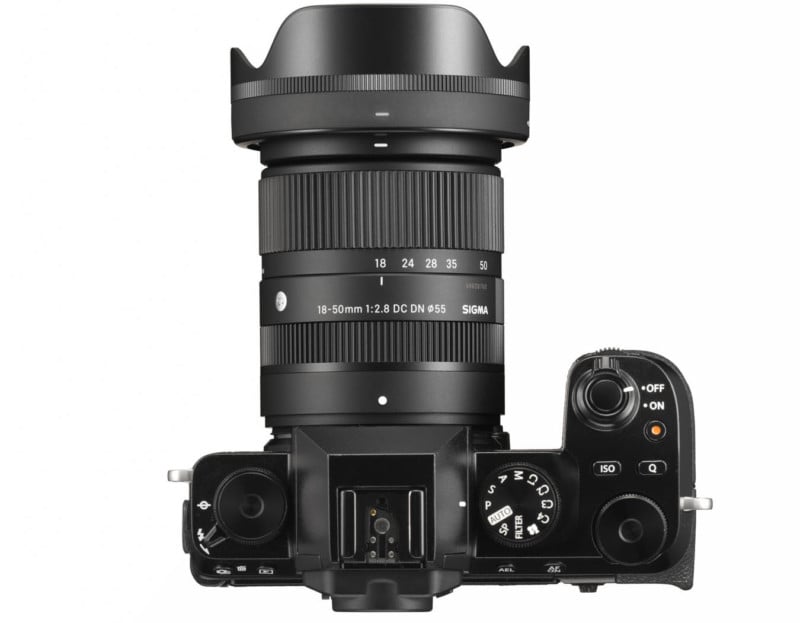
Fujifilm X Mount Lenses Are Becoming a Bigger Part of Sigma’s Business
DE: Since we spoke last July, you’ve also introduced a Fujifilm X Mount version of your 18-50mm f/2.8 DC DN Contemporary. It seems that you’ve been gradually expanding your offerings for X Mount for a little while now. Are you seeing a lot of demand for X Mount from customers? Is Fujifilm becoming a larger part of the market for you?
KY: Oh yes, there is surprisingly high demand. We are very surprised and we’re very happy that our products are being accepted by Fuji users.
DE: Yeah. I think Fuji is very strong these days, at least that’s my impression.
KY: Oh yes, they are one of the major players in mirrorless cameras.
DE: I think they appeal a lot to the enthusiasts. It’s interesting, I’d felt from the very beginning that their film simulations were really a key feature but it didn’t catch on a lot at first. Now, though, I think the market has really come around to that being something significant. – Probably because film is starting to come back too. But yeah, I’m not surprised that there’s demand. So far you have a limited number of lenses on X-mount, but we’ll see more transitioning.
KY: Yeah, yup.
I don’t have any way of easily following market-share information these days, but my impression is that Fujifilm has been doing very well. While I’m sure the same could be said of any camera maker to one extent or another, I’ve seen the dedicated effort they’ve made year after year now, largely unheralded by the photo press and consumers. Fujifilm isn’t as flashy about their tech as some companies, but they’ve made major advances in support of photographers’ and videographers’ creativity, and their deep history in film and color science has played a key role as well.
What Was the Key to Making the 18-50mm f/2.8 DC DC Contemporary?
DE: This is another one of those “what was the secret to…” questions: I don’t think we’ve discussed the 18-50mm f/2.8 DC DN Contemporary previously. It’s a pretty remarkable lens; I think it’s still the most compact and lightweight APS-C zoom lens on the market, and offers excellent optical performance at a very affordable price (currently $549 in the US), and it also has macro ability. (Although the lens-to-subject distance for maximum macro at wide angle is extremely small and there’s a lot of curvature of field. The 0.2x magnification at the tele end is much more usable.) What were the breakthroughs for that? It seems like a very special lens in many ways.
KY: Yes. There isn’t one single technology to achieve it, so we first set the concept that this lens must be compact and very lightweight. So our engineer did a great job. Firstly, we recognized that the prices of various camera bodies aren’t so expensive. There are some very high-end ones of course, but there are also many very affordably-priced cameras. So we believed that this lens must also be affordable. So we worked very hard to achieve that price point.
DE: Yeah, it really is pretty amazingly affordable, especially for the constant f/2.8 aperture – and for it to be so small, it really is incredible. I imagine that lens is selling very very well.
KY: Very well, yes, very well. It’s one of our top-selling items today.
DE: I’m curious about the weather sealing on the 18-50mm; I see that there’s a gasket on the mount, are there any other seals inside?
KY: It’s not weather sealed. We just put a gasket on the lens mount, that’s it.
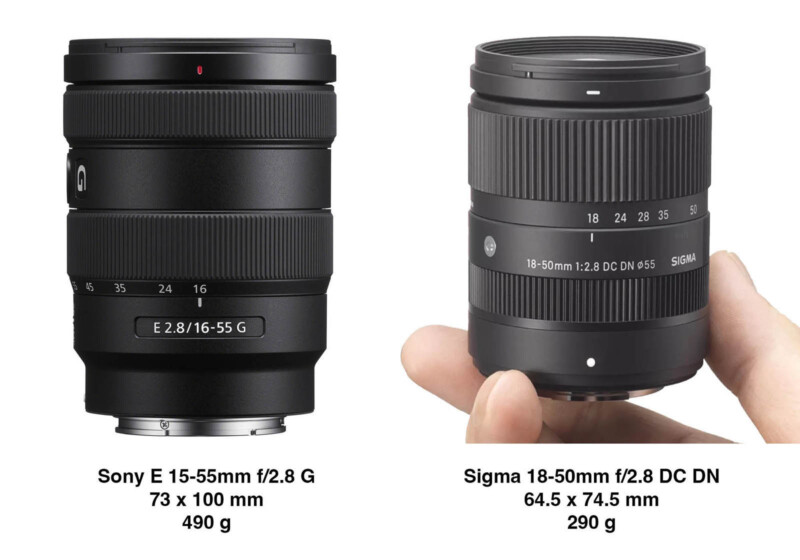
What Tradeoffs Let You Make the 18-50mm f/2.8 DC DN Contemporary So Compact and Affordable?
DE: Especially when you’re working to a price point, you can never optimize everything all at once. In the case of the 18-50mm f/2.8 DC DN Contemporary, it looks like the area where you had to give a little was geometric distortion and vignetting. Was that a part of the decision? To say “OK, we can’t have everything, so we’re going to make this very sharp with lower CA, but will give up a little distortion and vignetting to get there?
KY: Yeah, and it helped. There’s a great benefit to compromising in distortion and vignetting. The first part is that it greatly helps to reduce the size and weight. And also it helps us to correct the rest of the aberration. Spherical aberration, coma. By forgiving some of the distortion, we can focus on correcting the rest of the aberrations. And also, the correction of distortion and vignetting works very well.
DE: Yeah, right – it’s very easy to correct those in Photoshop.
KY: So if you look at the resulting pictures, the customer can get a really satisfactory result.
DE: Yeah, easily. By doing just a little work on their end in Photoshop, they can end up with a very nice image.
KY: Yes, it’s very difficult for a camera to correct coma and spherical aberration, field curvature. So we have to correct those optically. But distortion and vignetting can be corrected very easily.
DE: Yeah, that makes a lot of sense to me as a strategy. And it’s interesting to me to hear that those are the tradeoffs that make it easier to make it lighter, and probably less expensive as well.
It’s no easy task making an exceptional lens that sells for a few thousand dollars, but it takes real creativity to produce an excellent one that’s as lightweight, compact, and affordable as Sigma’s recent 18-50mm f/2.8 DC DN Contemporary. Its designer made very smart tradeoffs in areas that are easy for either the camera or photographer to correct post-capture, in favor of almost entirely avoiding ones that are difficult or impossible to correct in post. The net result is a remarkably compact and high-performing constant-aperture f/2.8 zoom lens that’s currently selling in the US for less than $500. Sigma is going to sell a lot of them.
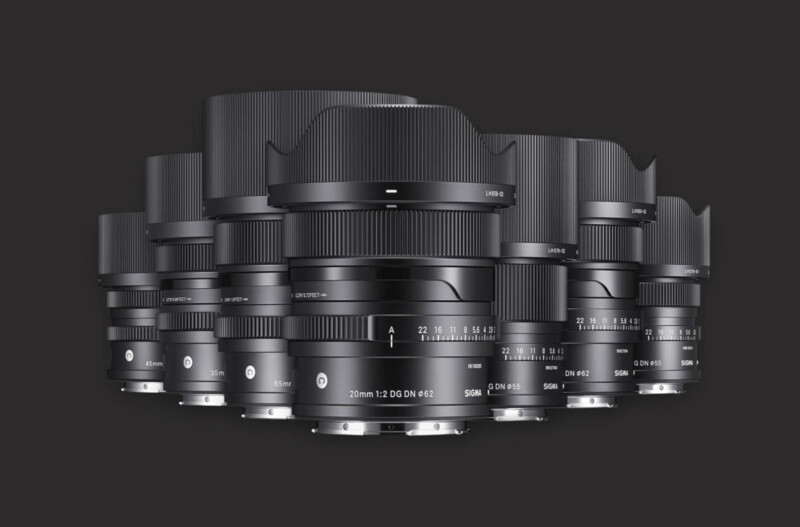
How Do You Decide Which Lens to Develop Next?
DE: This is an extremely open-ended question, but how would you describe your overall strategy in bringing new lenses to market? I’m actually not sure what question to ask here, but I’m curious about the process that leads to each new lens design.
KY: That’s a big question.
DE: Yeah, I’m trying to… What is the internal process or the strategy for you deciding to make a particular lens?
KY: Ahh, I see, ok. In Sigma there are three sources of ideas. First of all, we have the product planning team, so they come up with some proposals. And also I have some ideas, so I give some personal ideas. Then the engineers have some ideas because they are engineers and designers, but they are also consumers and photographers. So all together we meet together and discuss what the next project should be.
DE: That’s interesting… I think it’s very important that your engineers are photographers too.
KY: Oh yes.
DE: So you come together and people kind of throw out different proposals and then…
KY: Yes, they give many personal preferences and so on.
DE: They make the pitch for their concept, and then hopefully you decide what you’re going to do next.
KY: Yes, so eventually I make the final decision, but I try to listen as much as possible and then make the final decision to say “We should work on this next”.
DE: So within the group, they’ll make the argument for their preference, and people can understand each other’s arguments and reasoning. That’s interesting; in some corporations, not necessarily the photo industry, the marketing department decides what they need and then tells the engineers to go and make it. But this seems much more organic and very connected to photographers’ interests.
KY: Yes, I don’t want to make the engineers feel like slaves of the marketing team. They should have an equal position and be able to really exchange information. So I try to treat them equally, I listen to them.
DE: I think that’s a major secret of your success, actually, that you give so much … you show so much appreciation for the value of the engineers. For instance, the way you showed me that you have your desk right out on the floor with them.
KY: The motivation and passion of the engineers make the product very innovative and attractive. That’s what I believe. So my first priority is to motivate the engineers.
DE: As an engineer myself, I obviously approve of that.
This was very refreshing to hear, although it was also no surprise, having come to know Yamaki-san as I have over the years; he’s always held his engineers in the highest regard and respect. I’m sure that there are some optical designers at other companies who are photographers themselves, but I think Sigma’s unique in the extent to which photography permeates the entire company and the interests of its employees. Engineers who are themselves enthusiast photographers have an innate level of understanding of what makes a great lens that no amount of book learning or purely technical design expertise can substitute for.

What Are the Current Trends in the Lens Market?
DE: I probably ask you this every time we meet, but the market is constantly changing over time. What’s your 50,000-foot (15,240 meters) overview of how the market is evolving at this particular point in time?
KY: I see the demand for equipment is very different from customer to customer. I’m talking mainly about lenses of course. Some customers want zoom lenses, some customers only use prime lenses. So there is no mainstream trend for lens demand. From our point of view, we have to deliver the specific type of lenses for each type of customer.
DE: So you hear many different requests, and you need to try to satisfy each as best as you can. I have been seeing that video has become so much more important that things like focus breathing, quiet actuation, stepless aperture control, that sort of thing are becoming more important. I think focus breathing in particular is something that video people care about.
KY: Ah, yes, but as you know, we also provide cine lenses. So we know the professional cinematographers. And of course focus breathing is very important for that, and also parfocal designs. [Parfocal means that the focal distance doesn’t change as you change the focal length on a zoom lens. These are also sometimes referred to as “true” zoom lenses.] But there is no perfect lens. So I know that professional photographers or cinematographers can deal with a lens with some breathing or that isn’t perfectly parfocal. They know how to use it. But today, video reviews are so popular on YouTube that focus breathing has become very obvious and eye-catching, so people can easily point it out and say “Hey, this lens breathes”. In reality, though, you can use that lens without seeing obvious breathing in videos you make.
DE: Ah, that’s interesting; as in so many situations, the amateurs need better equipment than the professionals, because they need the gear to do it for them. [I actually missed Yamaki-san’s point here; He actually meant that video reviews of lenses can make small amounts of breathing obvious when in reality you wouldn’t notice it in real-world usage.]
DE: So that has become a factor in your lens design; you’re paying more conscious attention to reducing focus breathing?
KY: Oh yes, yes.
DE: I see, I’ve heard that from many manufacturers.
I was particularly struck by this point, having been so deeply involved in camera and lens testing myself over the years – and it’s why we always combined real-world shooting with our lab-based evaluations over at Imaging Resource. The ultimate question for us was always what users’ real-world experiences would be with the products we tested. It was always a balance; sometimes things that would stand out in lab tests might make less difference in real life, while other times things that might affect some real-world shots but not others could be smoked out in the lab testing. Looking only at lab results or only at real-world tests could easily over-emphasize or entirely miss a critical point. It seems like the former has often become the case with focus breathing. Quickly shifting focus from extreme closeup to infinity and back with a camera locked down on a tripod might make it look like a lens had obvious focus breathing problems when you’d be very unlikely to notice it when shooting actual footage. It’s a little unfortunate that online video reviews of lenses have called so much attention to the issue when lens designers might be able to achieve better overall performance if they weren’t forced to place so much emphasis on insignificant levels of focus breathing.
DE: Well, I think that was my last question, thank you as always for the excellent answers you’ve given. I know the readers appreciate them very much.
KY: Thank you very much.
Conclusion
As always, it was a fascinating conversation with Yamaki-san. He’s really unique among top photo-industry executives, not only in the surprising depth of his technical understanding but in his openness about the workings of his company.
This conversation was filled with many tidbits about optical design and manufacturing and how Sigma arrives at its new designs. Here’s a list of what we learned:
- Nikon has opened their Z mount to third parties and Sigma has released versions of their lovely and very affordable f/1.4 APS-C primes for the Nikon Z mount system, which also take advantage of Nikon’s in-camera aberration and distortion correction. This is great news for Nikon shooters and leaves Canon as the only major camera maker who hasn’t yet allowed others to make autofocus lenses for their RF mount. (It does bear noting though, that Nikon has so far restricted third parties like Sigma to lenses with sub-frame coverage. Hopefully, they’ll soon extend the relationships to cover full-frame lenses as well.)
- Sigma’s new 50mm f/1.4 DG DN Art lens for mirrorless cameras achieved amazing improvements in sharpness and aberration levels over the already-exceptional original 50mm f/1.4 DG HSM Art model announced back in 2014. We heard how aspheric elements correct for different parts of the image, depending on whether they’re located towards the front or the back of the lens. Yamaki-san also shared some insight into the general approach that led to the new design.
- I’ve always wondered how an optical engineer begins a new lens design: How on earth do they look at a blank sheet of paper and decide “Ok, I’m going to put this element here and that one there”? It turns out they don’t start with a blank sheet of paper, but refer to portions of previous designs, which Yamaki-san described as “start data”. After decades and dozens (and dozens) of lenses produced, Sigma’s engineers have an enormous database of such start data to work from. They can begin with a previous design, possibly borrowing parts of several designs, and then work on improving them. This cleared up what had been a great puzzle for me!
- We also learned a bit about how linear motors affect the size and layout of lenses. I was surprised to learn that rotary motors don’t add as much to a lens’s bulk as I’d expected, because they can be tucked into the lens barrel behind the focus unit, where the smaller diameters of the lens elements leave a little space naturally available. Linear motors can actually result in slightly larger lens barrels, since they’re ideally positioned next to the focus units, rather than behind them. Their advantages are more force per unit weight and volume though, and higher efficiency since energy isn’t lost in a gear train.
- While aspheric molding technology has had a huge impact on optical quality in recent years, it turns out that advancements in optical glass formulation have also played a critical role. I hadn’t been aware that glass technology is continuing to evolve as much as it has been.
- Relaxing constraints on things like vignetting and geometric distortion (that can easily be corrected either by the user in Photoshop or by the camera body itself) make it possible for a lens designer to achieve excellent sharpness and chromatic aberration in a compact lens like the Sigma 18-50mm f/2.8 DC DN Contemporary.
- Fujifilm seems to be enjoying great success in the market, as the X-mount is accounting for an ever-increasing level of demand among Sigma’s customers.
- Sometimes gear reviews drive manufacturers to push some performance criteria beyond the point that’s significant for real-world usage. Yamaki-san pointed to video reviews of lenses that can make focus breathing seem like a bigger issue than it is in real life. Rapid, extreme focus changes on a lens locked down on a tripod make even small amounts of focus breathing blatantly obvious. You might be hard-pressed to notice the effect in normal usage, but lens designers have to push beyond practical requirements for the sake of avoiding negative impressions of their lenses.
As always, an excellent and interesting interview, many thanks to Yamaki-san for spending time with me!
Feel free to leave any notes or questions for me in the comments below. I’ll monitor the comments threads for a week or so after posting this so I can respond to your questions.